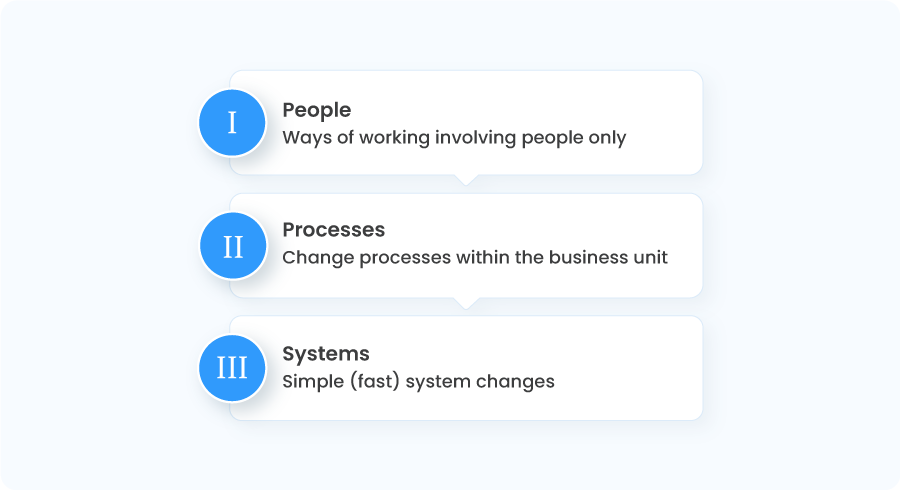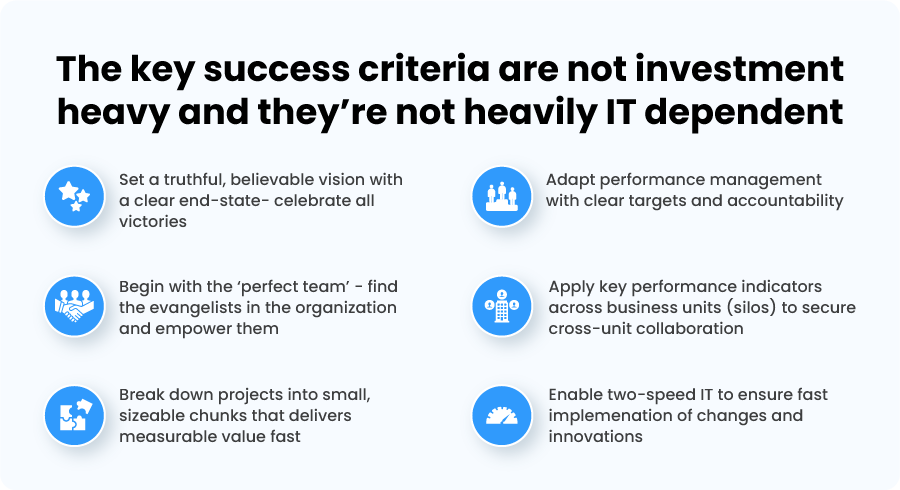Digital transformation is the key to success in today’s competitive landscape. With the right tools and strategies, you can drive tremendous growth and success for your business.
This digital transformation masterclass features two experts, Frederik Bisbjerg, Executive Director, Digitization, Daman National Health Insurance, and Gaurav Saini, Senior Manager – Presales, LeadSquared. They will be discussing techniques to successfully transform businesses.
What is digital transformation?
Digital transformation has been around for a long time, and it involves using technology to modify or create new business processes, culture, and customer experiences to meet changing market and business needs.
However, if this has been the case for so many years, why have we not been able to improve these processes of digital transformation? Let’s figure it out.
How digital transformation leads to business transformation
In order to effectively manage customer journeys, lead generation, and the overall customer experience, it is necessary to use tools and change the ways in which organizations work. This process, known as digital transformation, could better be referred to as business transformation. In essence, it involves implementing and using new tools, and changing the organization’s working practices to make the most of them.
Consultants report that a majority of digital transformation projects (70%) are unsuccessful, with two out of three or more companies failing to achieve their desired outcomes.
Frederik Bisbjerg, Executive Director, Daman National Health Insurance
We need to change the way we work in order to stay ahead of our competitors. To do this, digital transformation needs to be understood from its basis, so we can better understand how to approach business transformation.
Why do we need digital transformation?
In the past years, we have seen a rise in operational and CX challenges due to the Covid 19 pandemic. In response, companies have become more aware of the need to digitize their processes, leading to a surge in digital transformation across various industries.
Gaurav Saini,Senior Manager-Presales, LeadSquared
Most companies don’t have clarity on how much return they are getting from their marketing activities. This includes email campaigns, event attendance, and social media platforms. They don’t have insight into how many leads are being generated and how much of the pipeline is coming from different sources. In most cases, it is because companies do not have a digital solution in place.
In sales-led organizations, lack of visibility into field sales teams and long, competitive sales cycles are also a concern.
It is important to have the right message sent to customers at the right time, and for internal teams to work together to close leads and bring in sales. For this, representatives must be equipped with the necessary tools and methods to communicate with customers and nurture relationships in order to remain competitive. And that’s why digital transformation across different business functions is essential.
Digital transformation is not about digital first
Customer comes first not innovation or tech. We tend to overlook our customers and become too focused on improving processes that may not even meet their needs. This is why we don’t often achieve the desired outcomes.
When re-engineering business processes, it is essential to set a baseline by determining our current situation, numbers, processing times, KPIs and metrics.
In many companies, unified reports which show the metrics of the company as a whole are not available. This means that the data and numbers are not being used to their full potential.
Digital Transformation is essentially a process of re-engineering business processes, and the most common reason for projects of this nature to fail is a lack of a compelling vision that people can buy into. Without a clear goal, motivation is lost, and it is difficult to achieve the desired outcome.
It is not recommended to attempt to completely transform an entire organization in one go. This is likely to be unsuccessful as it is too much for the employees to handle and could lead to confusion. To ensure success, it is best to break down the transformation into small, manageable projects.
Start by identifying the most pressing issues and where the greatest opportunities lie. To do this, it is a good idea to review the organization’s value chain and speak to the senior management. Furthermore, it is important to have a clear vision of what the desired outcome of the transformation is. This will help ensure that the individual projects are all aligned towards the same goal.
Divide your core team into 3 standard units
In order to ensure successful transformation projects, it is important to focus on the people, processes, and systems involved.

People are the most important part of these projects, as they make up about 70% of the work, and if we focus on making them work better together, we can make significant progress.
Begin by considering processes and people and look at how they are working. You can then start to streamline processes without looking into the systems.
Once the processes are clear, it is time to look into the systems and automate them where possible to get the most out of them. At this point, involve other business units who may be affected by the process changes, and show them the good results you have achieved. This will help with business transformation. The best way to start is small. By focusing on the right people, you can control the process without losing oversight.
True transformation comes from people, so if we want to change, we must focus on enabling our colleagues to ask why we do things and if there is a better way. This also helps fuel transformation in the company, as the experts who work with the processes every day can tell us what they think is not the smartest way of working. This is a key part of any successful transformation project.
Frederik Bisbjerg, Executive Director, Daman National Health Insurance
Some of the key success criteria that are not investment heavy
It is important to identify key success criteria that are not overly reliant on IT. Transformation projects should be set up to demonstrate short-term wins as this will help to build credibility with top management. This will enable organizations to move forward with longer-term projects.

Having a truthful and believable vision for businesses is a key factor in creating a successful and sustainable organization. It sets the stage for success and allows employees to focus on the right goals.
If you are new to the organization and lack a track record of change, it is critical to find the perfect team. Make sure to choose people who are willing to change with you and understand what needs to be done. This could be people from various units. Having a motivated team from the start will make it easier to get things done faster and achieve results.
To successful company-wide transformation, break the project into smaller, manageable chunks. Just as with eating an elephant, you will eventually complete the task. Make sure to share reports, set a baseline for performance, and reward employees for successful outcomes. Financial incentives will lead to increased motivation, and thus an increased chance of success.
To get people to accept change, start small and involve marketing people to work with you. Explain to them why the change is beneficial to them and the company and make it as personal as possible. This will help them understand and buy into the new process, as it will make their lives easier.
There are two paths here: either the job you’re doing now will be fully automated in the next 1 or 2 years, or you can use the tools and support given to you to build the next generation and create a job for yourself.
Closing Remarks
Digital transformation has become an essential part of modern business operations, and its importance will continue to grow in the coming years. This transformation has the potential to revolutionize how businesses interact with their customers, increase efficiency, and reduce costs. To fully benefit from this transformation, businesses need to adopt the right technologies, develop new skills and leverage the best practices. With the right approach, digital transformation can create opportunities for businesses to improve their operational efficiency, gain competitive advantage, and enhance customer experience.
FAQs
The key elements of digital transformation include the adoption of new technologies, the integration of data and analytics, the use of automation, and the development of digital skills.
Digital transformation can help businesses become more agile and adaptive to changing customer demands and market conditions. It also helps businesses reduce costs, improve customer experiences, and gain insights through data analytics. Additionally, digital transformation can help businesses to increase their market share and gain a competitive advantage.
As with any major business change, there are risks associated with digital transformation. These include data security risks, implementation costs, and a lack of knowledge or resources. Additionally, digital transformation requires a cultural shift, which can be difficult for some organizations to manage and adopt. It is important for businesses to assess these risks and develop strategies to mitigate them.
So, are you ready to take your business to the next level? Learn how Leadsquared can help you leverage digital transformation to maximize your sales and customer engagement.
Take the first step today!
Speakers

Frederik Bisbjerg
Executive Director, Digitization, Daman National Health Insurance
Frederik Bisbjerg is a highly respected international business developer with expertise in digital transformation and business model innovation. His proven and numerous successes with worldwide business transformations come from his belief in enabling and empowering people to execute change strategies. He is Executive Director, Digitization at Daman National Health Insurance company, one of the largest insurers in the GCC countries, where he oversees the company’s digital transformation initiatives, building a digital-first flexible and resilient insurance company.

Gaurav Saini
Senior Manager – Presales, LeadSquared
Gaurav has over 15 years of experience in the software industry, namely CRM and BI solutions, for multiple verticals, including education, manufacturing, pharma, retail, and BFSI. At LeadSquared, he plays a crucial role in mapping customer requirements to the product and providing solutions to those requirements. Throughout his career, he has learned interpersonal skills, interfacing, CRM & ERP understanding, requirements capturing & analysis, then mapping same onto a solution by working closely with development teams.










